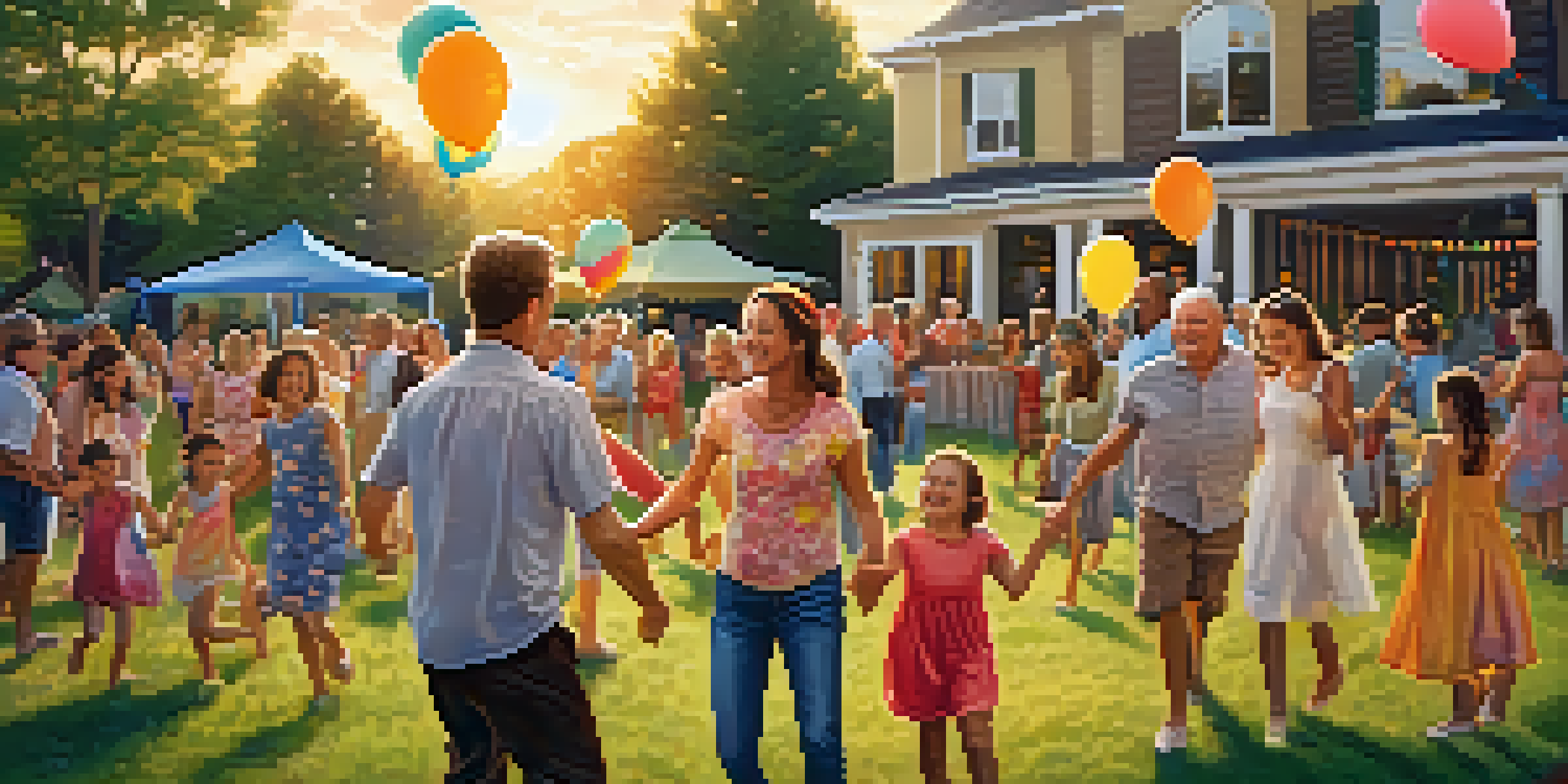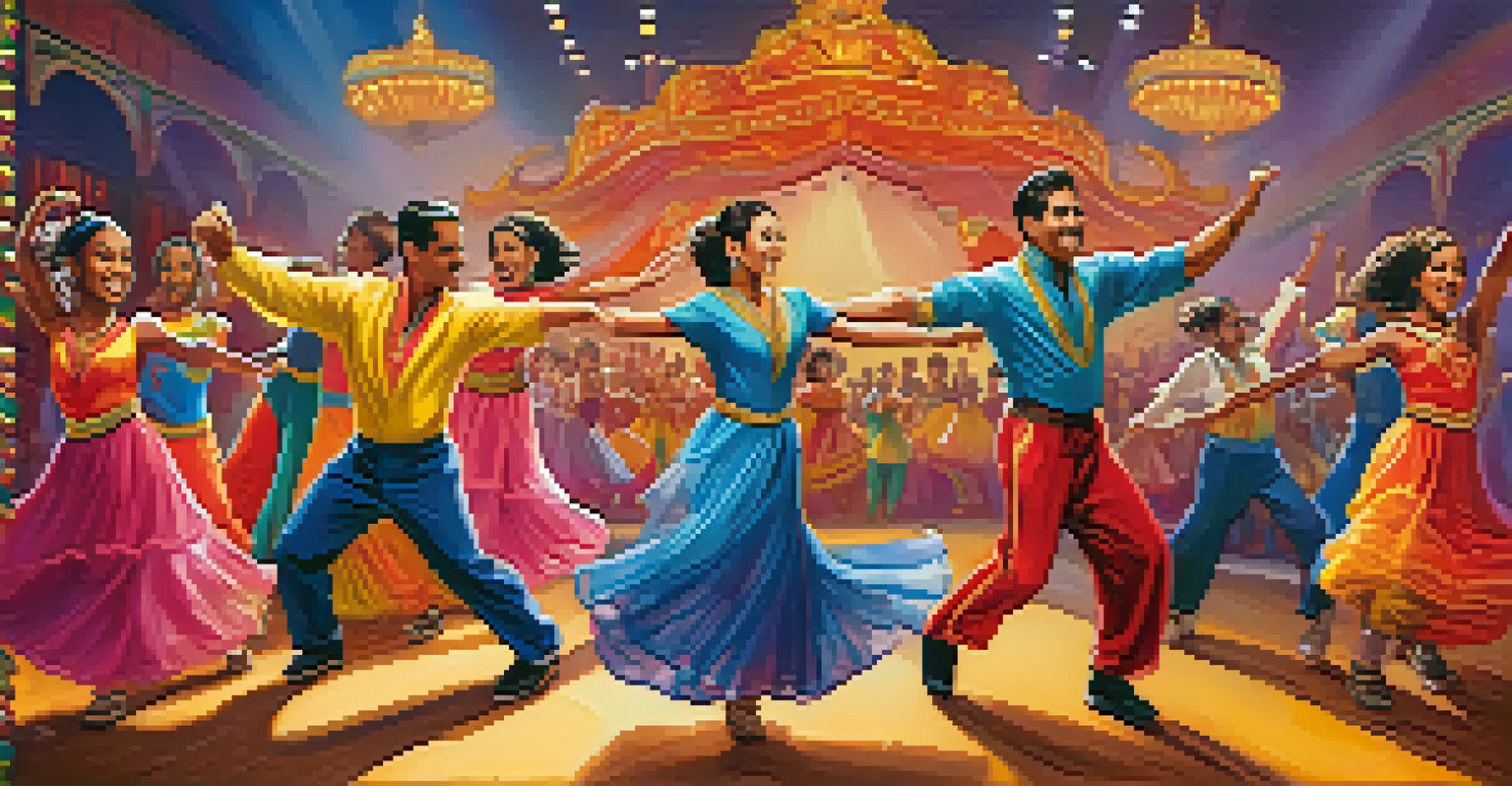The Role of Dance in Family Celebrations and Gatherings

Dance as a Universal Language in Family Events
Dance transcends barriers, creating a shared language among family members. Whether it's a wedding, birthday, or reunion, dancing allows everyone to join in, regardless of age or background. This universal appeal highlights the joy of moving together, strengthening familial bonds.
Dancing is like dreaming with your feet.
When families gather, they often bring diverse traditions and cultures into the mix. Dance becomes a way to celebrate these unique heritages, allowing individuals to express their identities through movement. For example, a family might incorporate traditional folk dances that tell stories of their ancestry, enriching the gathering.
Ultimately, dance fosters an environment of inclusivity and togetherness. As family members sway to the rhythm, they create lasting memories that can be cherished for years to come, reinforcing their connections in a fun and engaging way.
Creating Lasting Memories Through Dance
Every family celebration is an opportunity to create memories that last a lifetime, and dance plays a pivotal role in this process. Think back to a family wedding where the dance floor was alive with laughter and joy; those moments often become cherished stories shared for generations. Capturing those dances in photographs or videos only adds to their sentimental value.

Additionally, incorporating dance into family gatherings can set the stage for bonding activities. This could be as simple as a spontaneous dance-off or teaching each other a few steps from a popular dance trend. Such activities encourage interaction and laughter, making the event feel special and memorable.
Dance Strengthens Family Bonds
Dancing together fosters inclusivity and creates lasting memories, reinforcing connections among family members.
As families reflect on these gatherings, the shared experience of dancing often stands out. Those moments of joy and connection become the stories families tell and retell, weaving a rich tapestry of shared history that strengthens their ties.
Dance as a Tool for Emotional Expression
Family gatherings can sometimes stir up a mix of emotions, from joy to nostalgia. Dance serves as a powerful tool for expressing these feelings in a way that words may not capture. For instance, a slow dance shared between a parent and child can convey love, appreciation, and connection without uttering a single word.
Dance is the hidden language of the soul.
Moreover, when families navigate through challenging times, dance can offer a therapeutic outlet. Engaging in movement can uplift spirits, providing a release from stress or sadness. Families may find that coming together to dance helps them process their emotions collectively, reinforcing the idea that they can support one another.
In this way, dance becomes more than just a fun activity; it transforms into a vital emotional connector. The act of dancing together can facilitate healing, understanding, and ultimately strengthen familial bonds during both joyous and difficult times.
Incorporating Dance Traditions into Celebrations
Many families have unique dance traditions that add a special touch to their celebrations. These can range from traditional folk dances passed down through generations to contemporary group dances that everyone enjoys. Incorporating these traditions not only honors family history but also educates younger members about their roots.
For example, a family might have a specific dance they perform at every holiday gathering. This ritual not only brings joy but also fosters a sense of belonging and identity. It serves as a reminder of the importance of family heritage, creating a shared narrative that unites generations.
Emotional Expression Through Dance
Dance serves as a powerful tool for expressing emotions, providing a therapeutic outlet during both joyful and challenging times.
As families embrace and celebrate their dance traditions, they also create opportunities for learning and growth. Younger generations can be encouraged to join in, ensuring that these cherished customs are passed down, evolving with each new family member while maintaining their essence.
The Health Benefits of Dancing Together
Dancing isn't just fun; it also comes with a plethora of health benefits, making it an excellent addition to family gatherings. Engaging in dance can improve cardiovascular health, flexibility, and overall fitness levels. When families dance together, they not only bond but also contribute to their physical well-being.
Moreover, dancing releases endorphins, the body's natural mood lifters. This means that families can experience an increase in happiness and reduce stress levels while grooving to their favorite tunes. It's a win-win situation where everyone gets to enjoy and feel good at the same time.
By promoting an active lifestyle through dance, families can instill healthy habits in younger generations. Making dance a regular part of family celebrations encourages children to appreciate movement and exercise as enjoyable activities rather than chores, paving the way for healthier future lifestyles.
Dance as a Connector Across Generations
Family gatherings often bring together multiple generations, and dance serves as a bridge that connects them. Older family members can share traditional dances, while younger ones introduce new styles, creating a beautiful exchange of culture and creativity. This interaction fosters mutual respect and understanding across ages.
Imagine a grandparent teaching their grandchild the steps to a classic waltz, while the grandchild shows their grandparent the latest TikTok dance. These moments not only create laughter but also deepen relationships, as they learn from one another and find common ground through movement.
Legacy of Dance in Family Traditions
Incorporating unique dance traditions enriches family celebrations and helps pass down cultural heritage to future generations.
In this way, dance becomes a shared experience that transcends age barriers. It reminds families that despite their differences, the joy of dancing together can unite them, creating cherished memories that span across generations.
Encouraging Family Bonding Through Dance Activities
Incorporating dance activities into family gatherings encourages bonding and teamwork. Whether it's a choreographed group dance or a simple line dance, participation can create a sense of unity among family members. These activities help break the ice and get everyone involved, regardless of their dancing skills.
Consider hosting a dance competition or a dance-off during a family reunion. Such activities not only ignite friendly rivalry but also allow family members to showcase their talents and creativity. Laughter and joy are sure to follow, making the event memorable for all.

By encouraging everyone to join in, families build stronger relationships and create a more inclusive atmosphere. Dance activities promote interaction, laughter, and shared experiences, making family gatherings feel more connected and enjoyable.
The Lasting Legacy of Dance in Family Celebrations
As families celebrate milestones and create memories, dance becomes a lasting legacy that can be passed on. The joy and connection found in dance are often reflected in the stories told by family members for years to come. These narratives become part of the family's identity and history, enriching their shared experiences.
When families gather and share dance traditions, they are not just participating in an activity; they are also building a legacy of love and connection. Future generations will look back and remember the warmth of those moments, inspiring them to continue the tradition.
In essence, the role of dance in family celebrations goes beyond entertainment; it becomes a vital part of the family's story. As they dance together, families create a narrative that binds them, allowing their legacy to flourish through rhythm and movement.